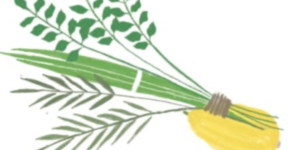From Yom Kippur, when we put aside our material existence by fasting and spending so many hours in prayer, we move within days to Sukkot. Sukkot is by contrast a very earthy, material holiday. There is the Sukkah booth itself and the plant material that makes up its roof. There are the Arba’ah Minim, the Four Species, as well — the lulav (palm), the etrog (citron), the hadasim (myrtles), and the aravot (willows). Sukkot helps us take the spiritual awakening we experience with the new year and bring it toward our material lives.
According to the Mishnah, Sukkot is one of the four Jewish New Year occasions, when “we are judged concerning water.” So many of the rituals of Sukkot involve water or praying for the winter rains. If you shake the Four Species together, it sounds like a rain shower!
Here is an explanation that builds on work done by Nogah Hareuveni, who founded Neot Kedumim, a nature preserve in Israel dedicated to biblical landscape and agriculture. (I think the interpretation is his, but since I can’t find it written exactly this way I’ll take responsibility if it differs.)
Dr. Hareuveni notes that the four species represent the only four different ways that plants can be watered. The palm is a tree of the desert oasis; it draws from deepest groundwater. The willows grow by a river, water constantly flowing on the ground. The myrtles require rain — dew or the periodic floods that go through a dry stream-bed (known as nachal in Hebrew or wadi in Arabic). The citron is a cultivated fruit, requiring irrigation — humans gathering and bringing water.
To the pagans living around our ancestors, each source of water came from a different source and could be traced to a different god. The Canaanites actually used the same word, baal, to refer to the “master” of their pantheon of gods, and to the condensation of rainwater on plants. In some texts, the waters of the deep are referred to as Mot, the god of death. These are the deep waters in our Genesis stories that originally covered everything and had to be held back to allow the ground to emerge, or that God released for Noach’s flood.
But the Israelites came to understand that the four waters were one, and had only one Source. So they bound the four disparate species together into one bundle, to symbolize the oneness of our God. The Four Species are waved in all directions, indicating an understanding that the one Source of waters and life is present everywhere.
Water remains a basic need, even in our technological society. It makes up most of our body and the surface of our planet. Our life from day to day, and our future as a species, depend on water, and many conflicts in the world or within societies are about access to water. For all those reasons, water is a common metaphor in our tradition for God and for Torah. And when everything is in alignment, the prophets describe perfection as perfect waves or an ever-flowing stream.